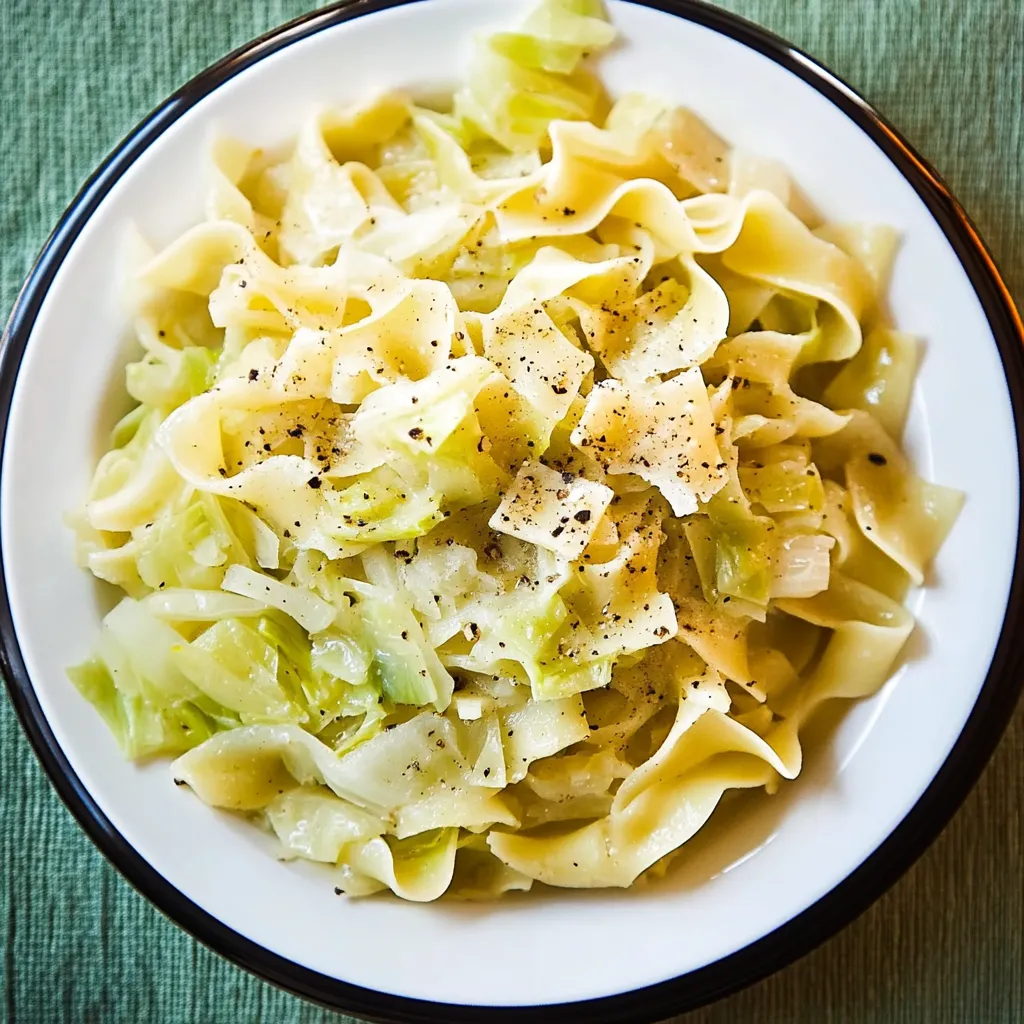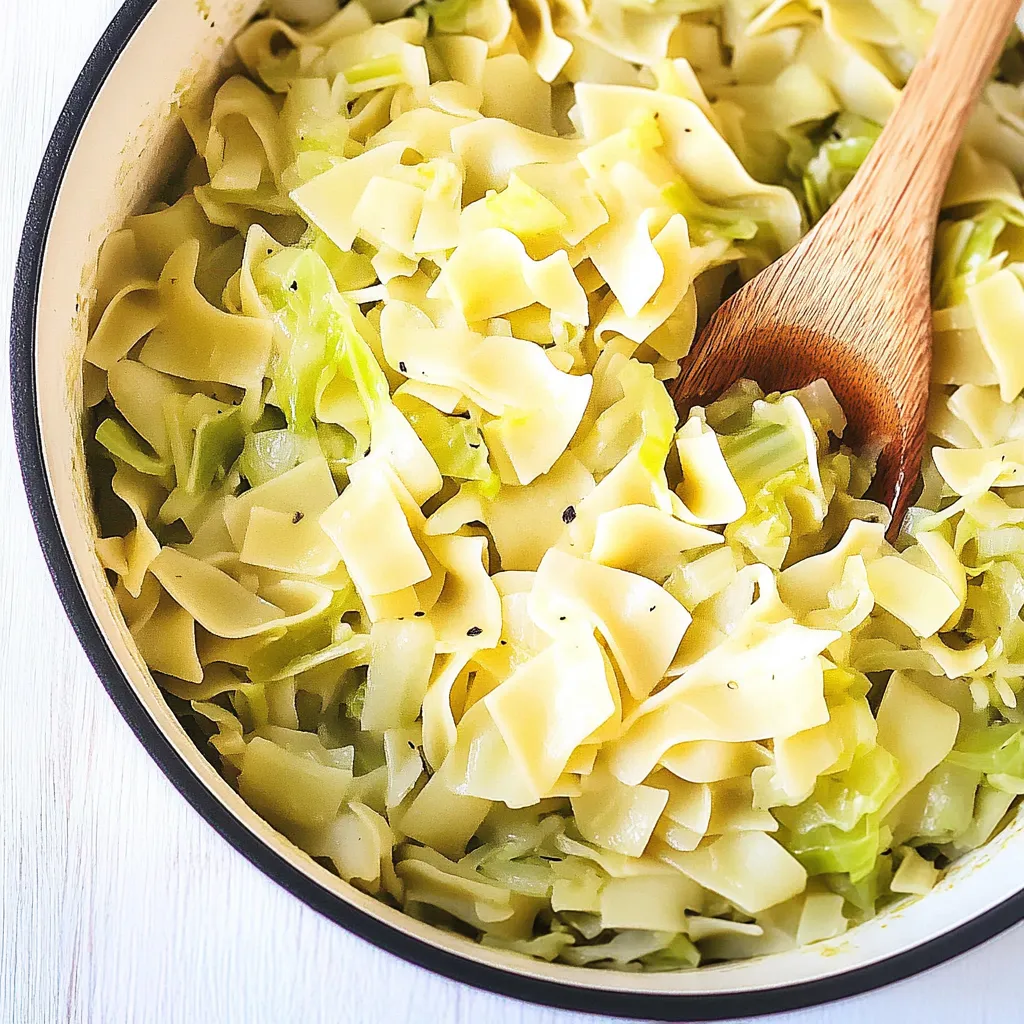 Pin it
Pin it
Simple, satisfying, and steeped in tradition, haluski transforms humble ingredients into a comforting dish that feels like a warm hug on a plate. This classic combination of buttery egg noodles and caramelized cabbage proves that sometimes the most basic recipes create the most memorable meals.
I first encountered haluski at a community fish fry during Lent in a small town where it seemed everyone had Polish or Eastern European roots. Though I had no family connection to the dish, one bite of those buttery noodles with sweet, caramelized cabbage convinced me this would become a staple in my kitchen. Years later, it remains my go-to recipe when I need comfort food that doesn't require a special shopping trip.
Ingredients
- Egg noodles – Wide egg noodles provide the perfect substantial base. Their slightly chewy texture and ability to hold butter make them ideal for this dish. Store-bought works perfectly, though traditionalists may insist on homemade.
- Butter – The soul of this dish is good butter, and plenty of it. It creates the silky sauce that coats every strand of cabbage and noodle, bringing rich flavor to otherwise simple ingredients.
- Onion – As it slowly cooks alongside the cabbage, onion develops sweet, caramelized notes that add remarkable depth of flavor. The natural sugars in onion help the cabbage brown more beautifully.
- Green cabbage – When sautéed until tender, cabbage transforms from a humble vegetable to something remarkably sweet and nuanced. Its texture provides the perfect contrast to the tender noodles.
- Salt and pepper – Simple seasonings are all this dish needs, with plenty of freshly ground black pepper being particularly important for balancing the richness of the butter.
Step-by-Step Instructions
- Begin boiling water –
- Fill a large pot with water and bring to a rolling boil. This is the perfect time to chop your cabbage and onion if you haven't prepared them ahead of time.
- Season the water –
- Once boiling, add a generous handful of salt to the water. This isn't just tradition – properly salted pasta water seasons the noodles from within, laying the foundation for a well-seasoned final dish.
- Cook the noodles –
- Add egg noodles to the boiling water and cook until al dente, usually 10-12 minutes or according to package directions. They should retain a slight chew as they'll continue cooking briefly when added to the cabbage.
- Prepare your cooking vessel –
- While the noodles cook, melt butter in a Dutch oven or large skillet over medium heat. A Dutch oven's high sides make it easier to stir everything together without spillage.
- Melt the butter –
- Don't rush this step. Allow the butter to melt completely and begin to foam slightly before adding vegetables. This indicates the water content is evaporating, concentrating the flavor.
- Cook the vegetables –
- Add chopped cabbage and onion to the melted butter, stirring to coat everything well. The vegetables should immediately begin to sizzle gently in the hot butter.
- Develop flavor through patience –
- Cook the cabbage and onion mixture for 10-15 minutes, stirring occasionally. The magic happens during this time as the vegetables soften, sweeten, and develop caramelized edges. You're looking for tender cabbage with golden-brown spots.
- Drain the noodles –
- When the noodles are done, drain them thoroughly but don't rinse. The starchy surface helps the butter sauce cling better to each noodle.
- Combine everything –
- Add the drained noodles directly to the cabbage mixture, tossing gently but thoroughly to combine. The residual heat from both components will help them meld together.
- Adjust and season –
- Add more butter if the mixture seems dry, then season generously with black pepper and additional salt if needed. The pepper isn't just a finishing touch – it's essential to the dish's characteristic flavor.
- Serve immediately –
- Haluski is at its absolute best when freshly made, with the butter sauce still glossy and the noodles hot.
 Pin it
Pin it
The transformation of cabbage during cooking is truly remarkable – what begins as a crisp, somewhat bitter vegetable becomes sweet, tender, and aromatic. The butter browns slightly as it cooks with the vegetables, developing nutty notes that elevate this simple dish to something truly craveworthy.
My grandmother always said that the key to excellent haluski is patience with the cabbage. She would spend a good twenty minutes slowly caramelizing it until the edges turned golden brown and the natural sweetness developed fully. "Rush the cabbage, and you miss the magic," she'd say as she stood guard at the stove, stirring occasionally with her wooden spoon worn smooth from decades of use.
The Cultural Significance
Haluski represents the ingenuity of Eastern European cooking, where humble, affordable ingredients transform into satisfying meals that could feed large families through harsh winters. While traditionally Polish, variations exist throughout Eastern Europe, each family adapting the basic formula to their preferences and available ingredients. This adaptability is perhaps why the dish has remained relevant for generations.
Perfecting the Butter-to-Cabbage Ratio
Finding your ideal butter amount might take a practice batch or two. Too little, and the dish feels dry; too much, and it becomes greasy. The perfect haluski has noodles and cabbage that glisten with butter without pooling it at the bottom of the dish. Remember that as the dish sits, the noodles will absorb some of the butter, so it's often better to err slightly on the generous side.
Seasonal Versatility
While traditionally a Lenten dish served in late winter and early spring when fresh produce was scarce, haluski's simplicity makes it appropriate year-round. In summer, try adding fresh herbs like dill or parsley from the garden. In fall, a handful of caraway seeds adds wonderful aromatic depth that complements the cabbage perfectly.
Frequently Asked Questions
- → What is Haluski?
- Haluski is a traditional Polish dish made with egg noodles and cabbage sautéed in butter. It's a simple comfort food that's especially popular in Pittsburgh.
- → When is Haluski typically served?
- Haluski is often served during Lent, but it makes a great side dish or main course any time of year, especially when you need to use up leftover cabbage.
- → Can I add meat to Haluski?
- Yes! While traditional Haluski is vegetarian, many people add bacon, kielbasa, or ham for extra flavor and to make it more substantial.
- → How do I store leftover Haluski?
- Store leftover Haluski in an airtight container in the refrigerator for up to 3-4 days. Reheat in a skillet with a little butter for best results.
- → Can I freeze Haluski?
- Yes, Haluski freezes well. Store in a freezer-safe container for up to 2 months. Thaw overnight in the refrigerator before reheating.
